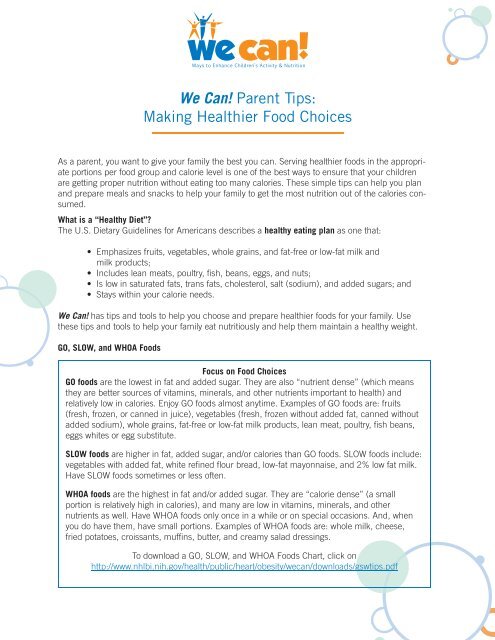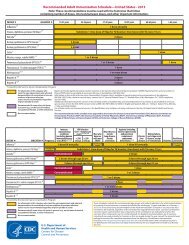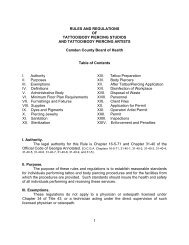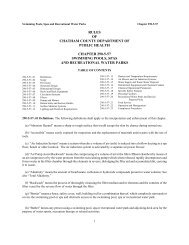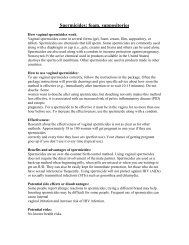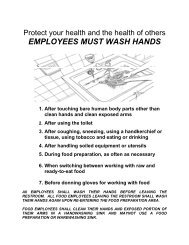Healthier Food Choices - Miami Valley Hospital
Healthier Food Choices - Miami Valley Hospital
Healthier Food Choices - Miami Valley Hospital
You also want an ePaper? Increase the reach of your titles
YUMPU automatically turns print PDFs into web optimized ePapers that Google loves.
We Can! Parent Tips:<br />
Making <strong>Healthier</strong> <strong>Food</strong> <strong>Choices</strong><br />
As a parent, you want to give your family the best you can. Serving healthier foods in the appropriate<br />
portions per food group and calorie level is one of the best ways to ensure that your children <br />
are getting proper nutrition without eating too many calories. These simple tips can help you plan <br />
and prepare meals and snacks to help your family to get the most nutrition out of the calories consumed.<br />
<br />
What is a “Healthy Diet”<br />
The U.S. Dietary Guidelines for Americans describes a healthy eating plan as one that:<br />
• Emphasizes fruits, vegetables, whole grains, and fat-free or low-fat milk and<br />
milk products;<br />
• Includes lean meats, poultry, fish, beans, eggs, and nuts;<br />
• Is low in saturated fats, trans fats, cholesterol, salt (sodium), and added sugars; and<br />
• Stays within your calorie needs.<br />
We Can! has tips and tools to help you choose and prepare healthier foods for your family. Use<br />
these tips and tools to help your family eat nutritiously and help them maintain a healthy weight.<br />
GO, SLOW, and WHOA <strong>Food</strong>s<br />
Focus on <strong>Food</strong> <strong>Choices</strong><br />
GO foods are the lowest in fat and added sugar. They are also “nutrient dense” (which means<br />
they are better sources of vitamins, minerals, and other nutrients important to health) and<br />
relatively low in calories. Enjoy GO foods almost anytime. Examples of GO foods are: fruits<br />
(fresh, frozen, or canned in juice), vegetables (fresh, frozen without added fat, canned without<br />
added sodium), whole grains, fat-free or low-fat milk products, lean meat, poultry, fi sh beans,<br />
eggs whites or egg substitute.<br />
SLOW foods are higher in fat, added sugar, and/or calories than GO foods. SLOW foods include:<br />
vegetables with added fat, white refined flour bread, low-fat mayonnaise, and 2% low fat milk.<br />
Have SLOW foods sometimes or less often.<br />
WHOA foods are the highest in fat and/or added sugar. They are “calorie dense” (a small<br />
portion is relatively high in calories), and many are low in vitamins, minerals, and other<br />
nutrients as well. Have WHOA foods only once in a while or on special occasions. And, when<br />
you do have them, have small portions. Examples of WHOA foods are: whole milk, cheese,<br />
fried potatoes, croissants, muffins, butter, and creamy salad dressings.<br />
To download a GO, SLOW, and WHOA <strong>Food</strong>s Chart, click on<br />
http://www.nhlbi.nih.gov/health/public/heart/obesity/wecan/downloads/gswtips.pdf
Parent Tips: Making<br />
<strong>Healthier</strong> <strong>Food</strong> <strong>Choices</strong><br />
Healthy Eating <strong>Choices</strong><br />
From WHOA to SLOW to GO. How you choose to prepare or order your food when eating out can<br />
quickly turn a less healthy food into a healthier option. Choosing baked, broiled, steamed, grilled,<br />
and microwaved foods saves you from extra fat and calories. See the example on how similar foods<br />
can go from a WHOA to a SLOW or to a GO food.<br />
WHOA (eat<br />
once in a while)<br />
Fruit Apple pie, 1/8<br />
of 9-inch pie<br />
Bread<br />
Meat<br />
½ plain bagel<br />
(3 ½ inch) with<br />
1 Tbsp butter<br />
and jelly<br />
Fried chicken,<br />
2 drumsticks<br />
Calories SLOW (eat<br />
sometimes or<br />
less often)<br />
296 Baked apple, 1<br />
cup slices, with<br />
1 Tbsp butter<br />
249 ½ plain bagel<br />
(3 ½ inch) with<br />
1 Tbsp jelly<br />
Calories<br />
GO (eat almost<br />
anytime)<br />
193 Apple, 1<br />
medium<br />
147 1/2 whole<br />
wheat bagel (3<br />
½ inch)<br />
386 Roasted Instead of: 193 Roasted<br />
chicken breast<br />
with skin, ½<br />
breast<br />
chicken breast<br />
without skin, ½<br />
breast<br />
Calories<br />
72<br />
91<br />
142<br />
You can go from WHOA to GO by making these substitutions when cooking. Substituting the lowfat<br />
and fat-free versions of foods as alternatives to the full fat items can help reduce overall calories<br />
of favorite foods without affecting taste. Try using low-fat mozzarella cheese in lasagna instead of<br />
the full fat variety. Your family will likely not notice the difference. Substitute applesauce for butter in<br />
baking and still get a rich, moist product. Try some of the calorie-reducing substitutions below when<br />
you cook or bake.<br />
Instead of:<br />
Substitute:<br />
1 cup cream 1 cup evaporated fat-free milk<br />
1 cup butter, stick margarine, or shortening for<br />
baking<br />
Tub margarine, vegetable oil, or ½ cup apple<br />
butter or applesauce without added sugar<br />
1 egg 2 egg whites or ¼ cup egg substitute<br />
Butter or stick margarine for sautéing<br />
Cooking spray, low-sodium chicken broth, or a<br />
small amount of olive oil or vegetable oil<br />
For more tips on making healthier substitutions, visit<br />
http://www.nhlbi.nih.gov/health/public/heart/obesity/wecan/live-it/cooking.htm<br />
Also, check out heart healthy recipes from the National Institutes of Health (NIH) at<br />
http://www.nhlbi.nih.gov/health/index.htm#recipes
Parent Tips: Making<br />
<strong>Healthier</strong> <strong>Food</strong> <strong>Choices</strong><br />
Making healthier selections when dining out. There are several things you can do at restaurants<br />
to lower your intake of fat and calories. For example, order foods that are steamed, broiled, baked,<br />
roasted, poached, or lightly sautéed or stir-fried. You can also trim visible fat from poultry or meat. In<br />
addition, request:<br />
• olive oil for dipping instead of butter or margarine<br />
• fat-free or low-fat milk rather than whole milk or cream in coffee or in other drinks<br />
• food without butter, gravy, or sauces<br />
• salad dressing “on the side” and request light or fat-free dressing<br />
• steamed vegetables or a fruit cup as a substitute for french fries<br />
• “hold the cheese” or “cheese on the side” when ordering sandwiches or salads so you can<br />
decide how much cheese you want to eat.<br />
• unsweetened beverages, such as water, unsweetened iced-tea, or sugar-free or diet<br />
iced-tea and lemonade.<br />
Portion Distortion<br />
Anyone who has eaten out lately is likely to notice how big the food portions are. It’s hard to fi nd<br />
“small” anymore --- “supersize” is more like it. Sometimes your plate arrives and there’s enough food<br />
for two or even three people. These ever-large portions have changed what we think of as a “normal”<br />
portion, and that affects how much food we eat at home as well. Cutting back on portion size can<br />
help you and your family limit your calorie intake. Follow these simple tips to get started:<br />
• Select an appetizer that is low in fat and includes a fruit or vegetable instead of an entrée<br />
at a restaurant.<br />
• Put a smaller portion on a smaller plate; it won’t look so skimpy.<br />
• Share a portion with a family member or friend.<br />
• Instead of giving your child or yourself an entire bottle of fruit juice or soda, pour a small<br />
amount (1/2 cup) into a cup. Better yet, choose water or small amounts of 100% fruit<br />
juice over soda.<br />
• Use tall, narrow glasses instead of short, wide glasses. You will drink less.<br />
• Order a medium pizza instead of a large. Everyone gets the same number of slices as<br />
before; they’re just smaller.<br />
• Before you eat your meal ask the wait staff to put half of the meal in a take home bag for<br />
leftovers to eat the next day.
Parent Tips: Making<br />
<strong>Healthier</strong> <strong>Food</strong> <strong>Choices</strong><br />
Compare the size of foods from 20 years ago to today. Portions have grown and so have the calories!<br />
20 Years Ago Today<br />
Portion Calories Portion Calories<br />
Bagel 3-inch 140 Bagel 6-inch 350<br />
Fast food<br />
cheeseburger<br />
1 333 Large fast food<br />
cheeseburger<br />
with sauces<br />
1 590<br />
Spaghetti and<br />
meatballs<br />
1 cup<br />
spaghetti,<br />
3 small<br />
meatballs<br />
500 Spaghetti and<br />
meatballs<br />
2 cups<br />
spaghetti,<br />
3 large<br />
meatballs<br />
1,020<br />
Soda 6.5 ounces 85 Soda 20 ounces 250<br />
Blueberry muffin 1.5 ounces 210 Blueberry muffin 5 ounces 500<br />
To test your knowledge on serving sizes, check out the Portion Distortion activity on the We Can! Web<br />
site, http://hp2010.nhlbihin.net/portion/index.htm.<br />
Visit the We Can! Web site, http://wecan.nhlbi.nih.gov or call 1-866-35-WECAN to order a free copy<br />
of the We Can! Families Finding the Balance: Parent Handbook.<br />
We Can!, or “Ways to Enhance Children’s Activity & Nutrition,” is a national education program<br />
designed for families and communities to help children achieve a healthy weight. The program<br />
focuses on three important behaviors: improved food choices, increased physical activity and<br />
reduced screen time.<br />
For more information about We Can! visit http://wecan.nhlbi.nih.gov or call 1-866-35-WECAN<br />
We Can! is an effort of the the National Heart, Lung, and Blood Institute (NHLBI) in collaboration with the National <br />
Institute of Diabetes and Digestive and Kidney Diseases (NIDDK), the National Institute of Child Health and Human <br />
Development (NICHD) and the National Cancer Institute (NCI).


